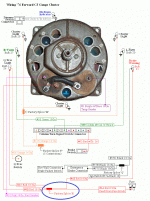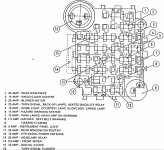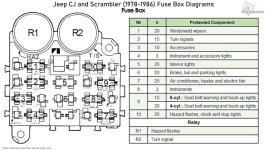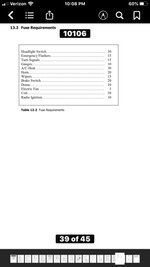Fuse value for fuel gauge?
- Forums
- Non Jeep Vehicles and ALL Parts and Accessories
- Any and ALL Aftermarket, Additions and Tools
- Body, Electrical, Chassis
You are using an out of date browser. It may not display this or other websites correctly.
You should upgrade or use an alternative browser.
You should upgrade or use an alternative browser.
Fuse value for fuel gauge?
- Thread starter jrberriospr
- Start date
Fuse value for fuel gauge?
gmillican
Jeeper
How about for the 12 volt ignition hot wire going to the Fuel Gauge? What value is that supposed to be?
TSB8C
Senior Jeeper
- Posts
- 802
- Thanks
- 411
- Location
- Cut-n-Shoot, TX
- Vehicle(s)
- 1984 CJ7, 420 HP "ZZ6 EFI" Crate engine, 700R4, D300, Dana30 front, Dana489 rear, 4.56 gears, 4" lift
The fuel gauge has three connections. The red switched 12V source comes from the fuse block through a fuse. Then you have the pink wire from the in-tank sending unit that provides a variable resistance to ground via a separate ground wire mounted to the frame at the rear near the tank. Then there is a third connection that is a jumper over to the temp gauge. This supplies about 5-6 volts to the temp gauge that then has a purple wire with a stripe going to the temp sensor on the engine (through the firewall junction block) which provides the variable resistance to ground through its mounting. A common issue that can cause problems with the fuel gauge is related to the factory splice in the wiring of that 12V switch hot feed. There is a splice that branches off the 12V source to also feed the brake warning indicator. and the 4WD or "Trac" indicator. These factory splices are notorious for getting rusty and corroded and causing loose and intermittent connections or increased resistance in the circuit. On the fuse block pic below, fuse #8 feeds the gauges and is shown to be a 7.5A fuse. Some diagrams also show a 10A (as "GRR" noted), and some show a 3A, depending on the year. I've seen issues with the 3A systems intermittently blowing that fuse. It's too borderline. I suggest you just pop a 10A fuse in there and don't worry about it, unless you are having wiring/splice issues to deal with.






gmillican
Jeeper
This is all great info above. I really appreciate it.
One issue I've been dealing with is that the Fuel Gauges from OMX ADA seem to be grounded from the S post on the Fuel Gauge to the Back of the body of the Fuel Gauge itself. That doesn't seem right to me. Won't that just cause current to go thru the case/Speedometer/Dash and short the circuit instead of going all the way to the back to seek its ground thru the Sending Unit?
One issue I've been dealing with is that the Fuel Gauges from OMX ADA seem to be grounded from the S post on the Fuel Gauge to the Back of the body of the Fuel Gauge itself. That doesn't seem right to me. Won't that just cause current to go thru the case/Speedometer/Dash and short the circuit instead of going all the way to the back to seek its ground thru the Sending Unit?
TSB8C
Senior Jeeper
- Posts
- 802
- Thanks
- 411
- Location
- Cut-n-Shoot, TX
- Vehicle(s)
- 1984 CJ7, 420 HP "ZZ6 EFI" Crate engine, 700R4, D300, Dana30 front, Dana489 rear, 4.56 gears, 4" lift
You are correct and that is definitely wrong. The "S" terminal is the connection for the sender unit in the tank. ("I" is for ignition source). It should not be grounded at all. It gets a variable resistance to ground based on the level of the float in the sender unit. If it is grounded all the time, it will just peg the gauge and never read the actual fuel level.
Now if you're reading that "S" terminal with an ohm meter (no wires attached) to the case of the gauge and seeing what appears to be a short to ground, then you are reading through the coil of the gauge itself, which while not zero ohms, is still low. That would be normal to see a very small amount of resistance between the fuel gauge "S" terminal and ground. But if you are saying that the Omix gauge actually has some type of grounded connection between the "S" terminal and the case of the gauge cluster, then that would be a problem.
Another possibility - are these some newer style aftermarket gauges with only two terminals on the fuel gauge. I've seen some of these that don't have the 3rd terminal on the fuel gauge for the strap that goes to the temp gauge. These newer style fuel gauges only have the "S" and the "I" terminals, and if not used along with the newer style temp gauge as a matched pair, they won't work right. With these newer style, the two "I" terminals should be connected. Here are the correct readings in ohms with no wiring at all on the stock style gauge:
Now if you're reading that "S" terminal with an ohm meter (no wires attached) to the case of the gauge and seeing what appears to be a short to ground, then you are reading through the coil of the gauge itself, which while not zero ohms, is still low. That would be normal to see a very small amount of resistance between the fuel gauge "S" terminal and ground. But if you are saying that the Omix gauge actually has some type of grounded connection between the "S" terminal and the case of the gauge cluster, then that would be a problem.
Another possibility - are these some newer style aftermarket gauges with only two terminals on the fuel gauge. I've seen some of these that don't have the 3rd terminal on the fuel gauge for the strap that goes to the temp gauge. These newer style fuel gauges only have the "S" and the "I" terminals, and if not used along with the newer style temp gauge as a matched pair, they won't work right. With these newer style, the two "I" terminals should be connected. Here are the correct readings in ohms with no wiring at all on the stock style gauge:
- S to Ground 68-72 ohms
- S to I 19-21 ohms
- S to A 19-21 ohms
- I to A Zero
- I to Ground 49-51 ohms
- A to Ground 49-51 ohms
- 73 ohms empty
- 23 ohms half tank
- 10 ohms full
Jeep-CJ Donation Drive
Help support Jeep-CJ.com by making a donation.
Help support Jeep-CJ.com by making a donation.
Goal
$200.00
Earned
$0.00
This donation drive ends in

